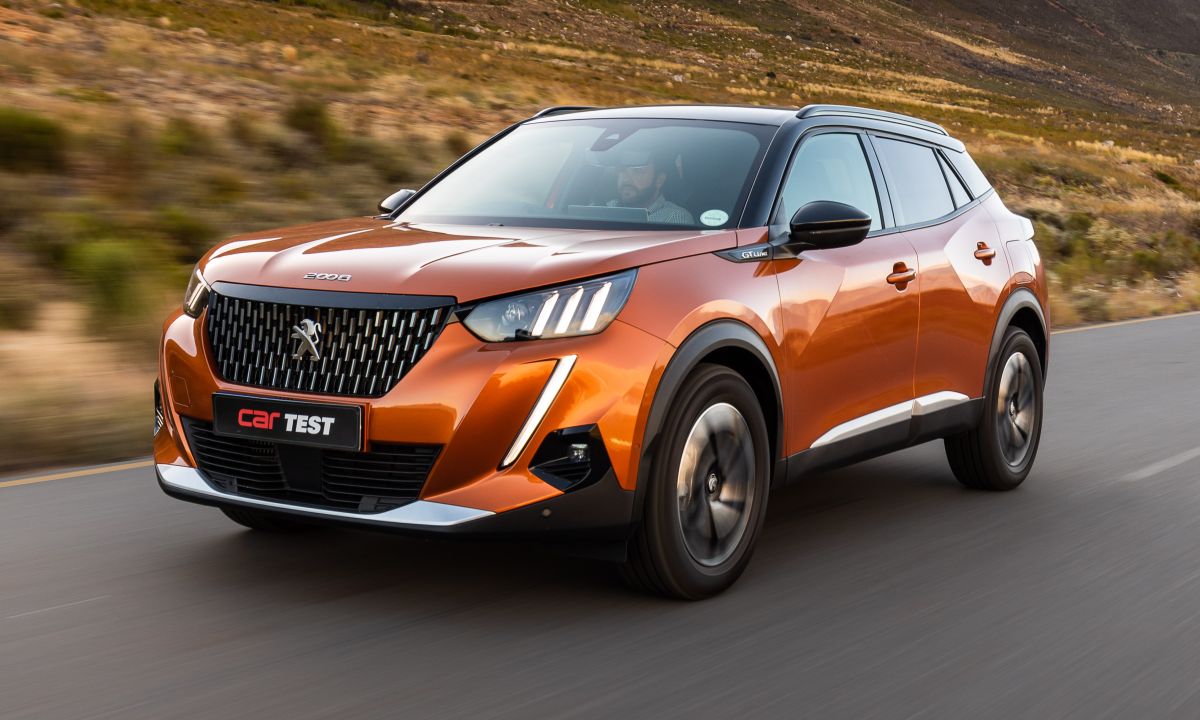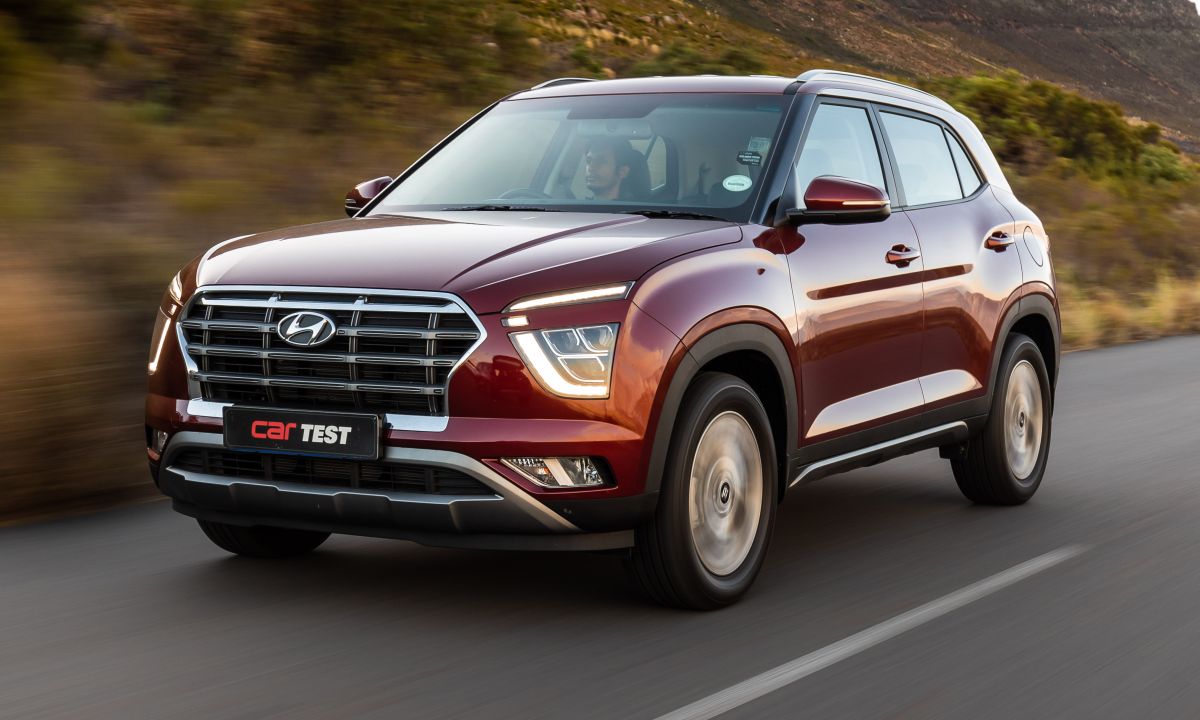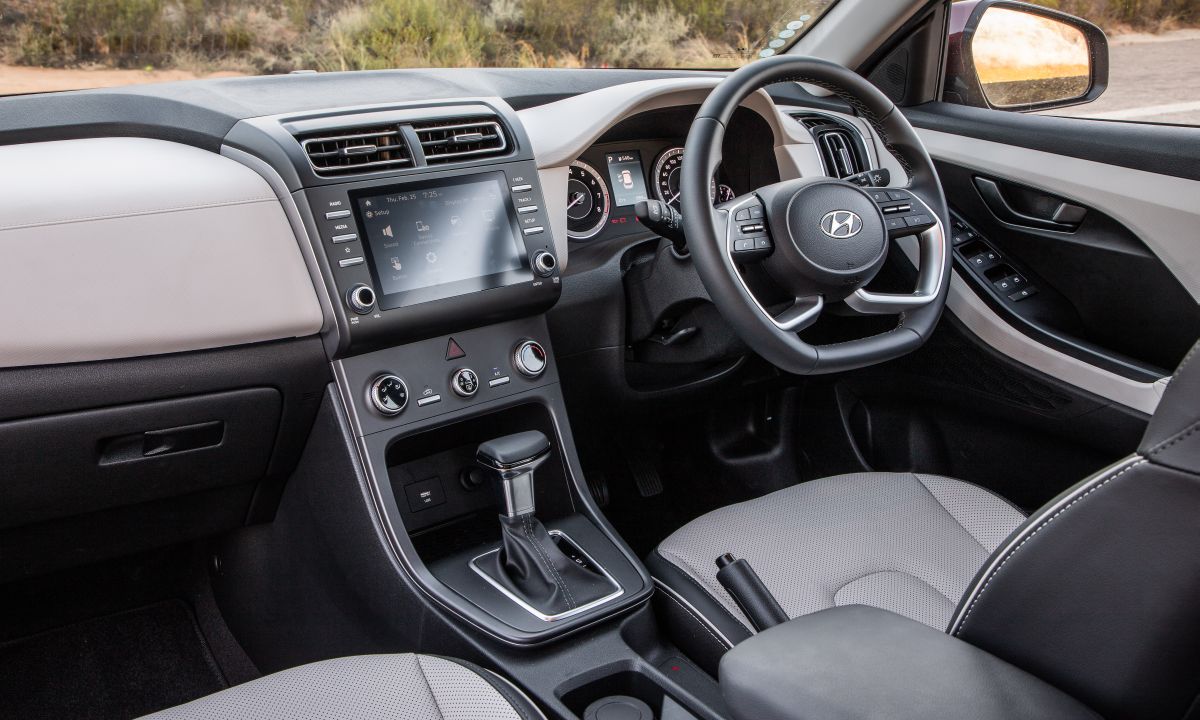In the age-old strategic game of noughts and crosses, all that’s required is a couple of players, each equipped with a pencil and a nine-square grid drawn on a single piece of paper. In the booming SUV/crossover segment, myriad carmakers have committed to outwitting their competitors to make their mark on the grid.
According to our Top 12 Best Buys awards (April 2021 issue), the reigning champion is the Volkswagen T-Cross, with the German firm placing three winning crosses in a row for the last two years.
However, which one of these crossover vehicles – the new Hyundai Creta, Mazda CX-30, Peugeot 2008 or an older favourite, the Nissan Qashqai – will be able to outwit the Wolfsburger? Our road testers’ pencils are drawn. Let the games begin.

The understudy: Mazda CX-30 2,0 Active AT
Rating: 3,5 stars
The Mazda is arguably the most dynamically involving crossover in this company. With the driver’s pew dialled to its lowest setting and leather-trimmed telescopic steering column adjusted as desired, the CX-30 – although riding 35 mm higher off the ground than the fourth-generation Mazda3 upon which it is based – offers a near hatchback-like driving position.
Not possessed of such a commanding view of the road like its taller-riding rivals, it nonetheless offers its pilot a clear view of their surroundings and standard-fitment head-up display, contributing to a driving experience that is very nearly as dynamic as that of the 3. With the comfortable cloth-upholstered driver’s seat adjusted just so and the engine start button depressed (keyless entry is, however, absent in the entry-level Active derivative), the Japanese firm’s newcomer was poised to make its mark on the grid.
The Mazda’s dynamism immediately impressed. The most powerful vehicle here, on our test strip it was the quickest to accelerate to the 100 km/h marker from standstill, with a sub-10-second sprint time. Through the 40 km/h increments, the Japanese crossover bolstered its lead, accelerating from 60-100 km/h in 5,28 seconds and 80-120 km/h in 6,94. However, it fell short in the emergency braking stakes, receiving a “good” rating compared to its competitors’ “excellent” ratings. With tarmac disappearing in the Mazda’s auto-dimming rear-view mirror, the road to Franschhoek was where the Mazda would acquaint itself with its rivals on the cover shoot the next morning.

The CX-30 performed well en route to the location and with cruise control activated, the transversely mounted inline-four did a commendable job of keeping the Mazda on pace with traffic at the national limit. Although the 2,0-litre motor is devoid of forced induction, the SkyActiv unit is the liveliest powerplant of the four, generally working well with the six-speed automatic transmission. We say generally because, on the back of the country’s move to level-one lockdown restrictions, driving on once-quiet roads now choked with early-morning traffic did unearth a minor kink in the automatic transmission’s otherwise slick workings.
Overtaking may have required less time in the CX-30 than in the other crossovers but after pulling past slower-moving traffic, its transmission tended to remain in a lower gear ratio for a prolonged period, sending a fair amount of mechanical noise into the otherwise well-insulated cabin.
Road noise was kept to a minimum thanks to the high-profile rubber wrapped around this model’s 16-inch Grey Metallic alloy wheels, soaking up road imperfections and the odd piece of gravel with aplomb. As a result of its well-weighted steering, taut chassis and lowest centre of gravity, a stint up the picturesque pass revealed the front-wheel-drive crossover’s agile demeanour. It felt composed and eager, with only a hint of noticeable body lean around the bends.
Another accolade went to the CX-30’s screen mirroring-enabled MZD Connect setup (no touchscreen here), which we’ve previously lauded for its ease of use. It’s the most user-friendly system to operate on the move on account of the tactile centre console-mounted roundel and multifunction steering wheel. The 8,8-inch display was crisp and the menus easy to navigate. There was, however, some curious omissions from the Mazda’s standard specification list. These included park-distance sensors, a reverse-view camera and automatic climate control.
Mazda CX-30 2,0 Active AT
Price: R469 000
Engine: 2,0-litre, 4-cyl, naturally aspirated
Transmission: 6-speed automatic
Power: 121 kW @ 6 000 r/min
Torque: 213 N.m @ 4 000 r/min
0-100 km/h: 9,95 seconds (tested)
Fuel consumption: 7,00 L/100 km (fuel route)

The master: Peugeot 2008 1,2T 96 kW GT Line EAT6
Rating: 4 stars
Striking is an appropriate description of the Peugeot’s exterior design. Our top-spec test unit was dressed in a two-tone Orange Fusion and black paint scheme (a black contrast roof is standard on the GT Line derivative). The 2008’s daring bodywork wasn’t divisive and some of the potentially challenging elements – such as the intersecting sheet metal creases on the flanks – even met with approval from the majority of the team.
Notable exterior items are the automatic headlamps’ claw-effect LED daytime-running lights; sited on opposite sides of the front bumper, they look as though they were carved into the facia. The French manufacturer says they are reminiscent of sabre-tooth cats.
Approaching the 2008, the triangularly contoured doors automatically unlocked. As the tallest riding vehicle in this pack, its occupants are afforded easy ingress into the cabin. A neat and practical design feature, the 2008’s doors extend beyond the door sills. This prevents sullying your fashionable trousers following gravel or mud driving, both of which the 2008 does surprisingly well but more about the Peugeot’s driving manners later.
Like its exterior, the interior is fashionable, with the cabin’s contemporary design tailored in myriad soft-touch materials, replete with lime-green contrast stitching and featuring eight-colour ambient lighting. Thankfully, interior build quality has not been sacrificed at the altar of fashion. The Peugeot’s interior fitment is on par with the Mazda’s sturdy cabin assembly. One team member noted the quality of the 2008’s dashboard-mounted switchgear surpasses that found in a certain German brand’s crossovers … that’s fighting talk.

Incorporated above the latter are touch-enabled buttons which, among others, provide access to the screen mirroring and vehicle status (including tyre-pressure monitoring) menus, and satellite navigation – displayed on a 10-inch touchscreen – and front seat heating. An inductive smartphone charging bay is located in a designated stowage compartment. The 2008 is the best-equipped crossover here. Included as standard are fore and aft park-distance sensors with a semi-360° surround-view camera, automatic wipers, driver-assistance systems such as cruise control, blind-spot monitoring and lane-keeping assist, as well as an additional Isofix anchorage on the front passenger seat.
The stand-out feature is Peugeot’s latest instrument arrangement. A first on a production car according to the French manufacturer, the 3D i-Cockpit can be configured to relay various information feeds such as navigational directions to the driver. The angular steering wheel did have to be set lower than in other cars to view the digital display and, once the driver’s pew was fine-tuned to the correct seating position, the French crossover is a joy to inhabit. The 2008 boasts the most headroom up front, yet, the least amount of rear kneeroom and packing capacity of the quartet. The cloth-and-faux leather driver’s chair is well bolstered and comfortable.
The engine start button did require a prolonged prod to get the 1,2-litre motor fired up, but once the 2008’s turbo-triple was turning and an endearing three-cylinder thrum permeated the otherwise quiet cabin, it punched well above its weight, producing the best torque of the four. The first Peugeot underpinned by the manufacturer’s Common Modular Architecture (CMA) platform, the 2008 felt nearly as agile as the CX-30 but couldn’t quite best the Mazda’s tested acceleration figures. However, the Peugeot offered the most supple suspension setup.
The steering felt delightfully, ahem, light when manoeuvring at low speeds and, when the holographic tachometer edged past 1 750 r/min and the full 230 N.m of torque was directed to the front axle, it relayed ample feedback to the driver despite a touch of turbo lag in the lower rev range. A positive upshot of the i-Cockpit’s unique steering-wheel setup is a heightened sense of steering immediacy.
Bolstering its appeal as a lifestyle crossover – you’ll note the plastic cladding around the wheel arches and the roof rails – the 2008 is equipped with Peugeot’s e-differential-mimicking grip-control system. In addition to Normal mode, this configurable traction-control system offers Mud, Sand and Snow drive settings. Sand mode activated, the Peugeot felt composed over loose surfaces.
Peugeot 2008 1,2T 96 kW GT Line EAT6
Price: R479 900
Engine: 1,2-litre, 4-cylinder, turbocharged
Transmission: 6-speed automatic
Power: 96 kW @ 5 500 r/min
Torque: 230 N.m @ 1 750 r/min
0-100 km/h: 10,46 seconds (tested)
Fuel consumption: 7,0 L/100 km (fuel route):

The longshot: Hyundai Creta 1,5 Executive IVT
Rating: 3,5 stars
Enter the Hyundai Creta. Parked alongside its rivals, the Hyundai’s exterior styling generated a fair amount of debate among the CAR team. Dressed in Lava Orange paintwork, some described the Creta’s fore and aft styling as “challenging”, while others noted the split head- and taillamp arrangements – the former featuring auto-on functionality and incorporating LED daytime-running lights – looked futuristic.
Opinions were also divided on the design treatment doled out to the 17-inch alloy wheels. Adding to the Indian-built crossover’s lifestyle-orientated demeanour are plastic mouldings for the wheel arches, faux diffusers fore and aft, and a set of roof rails. The latter items are, unfortunately, solely for cosmetic purposes. In short, the Creta’s outward appearance is an acquired taste.
In stark contrast to the exterior’s distinct design elements, the interior styling is minimalistic and the cabin layout conventional, with an eight-inch touchscreen display with Apple CarPlay, Android Auto and Bluetooth functionality. The infotainment interface is straightforward and easy to navigate, although, as with the Peugeot and Nissan’s touch-enabled units, it required a glance away from the road when on the move. Luckily, a pleasingly tactile multifunction steering wheel is included with the entry-level Executive derivative.
Rear-park-distance sensors and reverse-view camera, cruise control and an electrochromatic rear-view mirror are standard in Executive specification. Much like the CX-30, the Creta had some curious omissions from its equipment list. Some team members remarked they would have preferred keyless entry and start, automatic climate control and wipers above the Hyundai’s standard wireless smartphone charging.
Generously equipped for its asking price, the Creta’s perceived interior build quality feels a step behind that of its rivals But the steering wheel and gearlever are trimmed in hide and the seats upholstered in faux leather. Together with the Creta’s large glasshouse and the test car’s light-coloured interior finish, the cabin felt more spacious than its exterior dimensions suggest. Thanks to its boxy bodywork, the Hyundai offered the largest utility space (1 088 litres) of the four crossovers.

The least powerful crossover in this company, the Creta’s naturally aspirated motor produces 84 kW and 143 N.m om torque. However, its 1,5-litre engine is mated with a continuous variable transmission called IVT that, while not necessarily class leading, was more warmly received by the team than the Qashqai’s Xtronic item.
As a result of the Creta’s lightweight construction (tipping the scales at 1 214 kg it’s the lightest crossover) and transmission, it bested its aforementioned Japanese rival in the 0-100 km/h sprint by nearly two seconds and recorded 60-100 km/h and 80-120 km/h times of 2,15 and 2,86 seconds quicker than the Qashqai’s, respectively. Slower in the acceleration stakes than the Mazda and Peugeot, what the Creta lacks in performance, it compensates with its frugal powertrain. The four-cylinder petrol engine sipped a mere 5,90 L/100 km on our standardised mixed-use fuel route.
In terms of driving manners, the Hyundai takes a more relaxed approach to travel than the others. Its driving manners lack dynamic poise with the power-assisted steering feeling too softly weighted at times and, owing to its upright dimensions, there is a fair amount of body roll through the corners. However, the Creta remains a comfortable, practical and frugal crossover to pilot.
Hyundai Creta 1,5 Executive IVT
Price: R432 900
Engine: 1,5-litre, 4-cyl, normally aspirated
Transmission: CVT
Power: 84 kW @ 6 300 r/min
Torque: 143 N.m @ 4 500 r/min
0-100 km/h: 11,47 seconds (tested)
Fuel consumption: 5,90 L/100 km (fuel route)

The veteran: Nissan Qashqai 1,2T Midnight Edition Xtronic
Rating: 3,5 stars
An old favourite of the CAR team, the Qashqai entered this comparative test in Midnight Edition guise. Dressed in Magnetic Red body colour, the oldest crossover of the test arrived at the location eager to prove itself against the newcomers and, again, leave a positive impression on the CAR team before it’s replaced by the new-generation model later in 2021. The first iteration of the Qashqai was unveiled in 2006, with the second-generation version following several years later.
In 2017, Nissan decided to teach the latter model some new tricks and handed the second Qashqai some exterior and interior upgrades. Three years later, the Midnight Edition variant joined the local line-up. Has Nissan fine-tuned its Qashqai strategy enough to prove itself a worthy contender on the grid?
Off the bat, the Qashqai certainly didn’t look out of place. Setting this derivative apart from its standard stablemates, the Midnight Edition sports 19-inch Black Wind alloys, darkened exterior detailing for the V-shaped grille insert and front bumper inserts, plus a gloss black finish for the side mirror caps. Flanking the grille, the headlamp clusters house arrow-shaped LED daytime-running lights.
Giving away the Qashqai’s years was the small seven-inch touchscreen display. Ironically, where the majority of modern vehicles are switching to touch controls, the Qashqai’s analogue items were refreshing in this company. The technologies found inside are bang up to date; the Qashqai’s infotainment setup features Apple CarPlay and Android Auto, Bluetooth functionality and satellite navigation. Dual-zone climate control is also present, as are auto-on headlamps and wipers, and 360° surround-view camera. Driver-assist systems include cruise control and blind-spot monitoring.

The Qashqai’s cabin is neatly trimmed in a combination of leather and Alcantara for the seats. Perceived build quality is sturdy. Even though it’s not quite as spacious as the Peugeot up front, passengers seated on the Nissan’s Isofix-enabled rear bench are afforded the most head- and legroom, with a generous 956 mm and 712 mm on offer, respectively. The Qashqai’s luggage compartment was also the largest. Our ISO blocks measured out a handy 272 litres of boot space. However, with the 60:40-split aft seatbacks folded down, the Qashqai couldn’t quite best the utility capacity offered by the Mazda and Hyundai.
On the move, the Qashqai treads along in a leisurely fashion. The Nissan’s suspension arrangement does an admirable job of keeping occupants undisturbed. Owing to its low-profile Michelin Pilot Sport 4 rubber, though, a few jolts permeated the Qashqai’s innards when driving on gravel roads.
The heaviest crossover in the pack, the Qashqai’s 85 kW/165 N.m four-cylinder, turbocharged petrol motor fell short during performance testing, with the Qashqai’s 1 396 kg kerb weight and lethargic CVT curtailing the engine’s enthusiasm. It was the slowest of the four on the test strip, with a 0-100 km/h sprint time of 13,4 seconds. Because of the Xtronic transmission’s languid workings, the Nissan’s 60-100 km/h time of 10,59 seconds and 80-120 km/h in 15,45 seconds left much to be desired.
The Qashqai did excel in our 10-stop emergency braking tests. The combination of the Nissan’s ventilated front and solid rear discs and sticky Michelin rubber did an excellent job of bringing it to a halt. The Qashqai was not only the quickest vehicle to come to a standstill, but was the only crossover that managed to do so in less than 40 metres.
Nissan Qashqai 1,2T Midnight Edition Xtronic
Price: R492 500
Engine: 1,2-litre, 4-cyl, turbocharged
Transmission: CVT
Power: 85 kW @ 5 200 r/min
Torque: 165 N.m @ 1 750 r/min
0-100 km/h: 13,40 seconds (tested)
Fuel consumption: 7,40 L/100 km (fuel route)

























